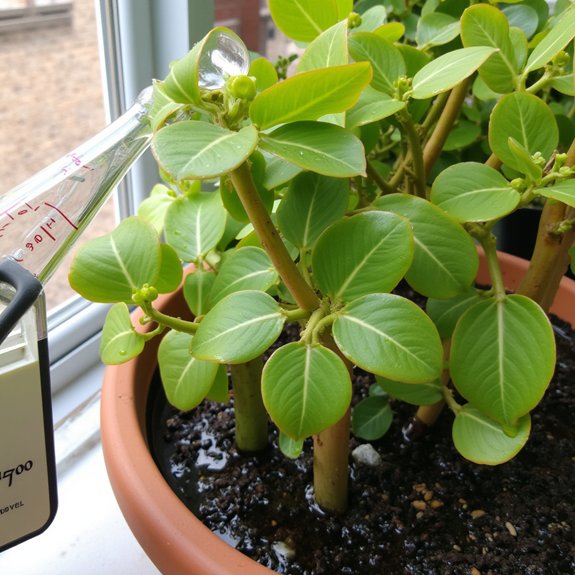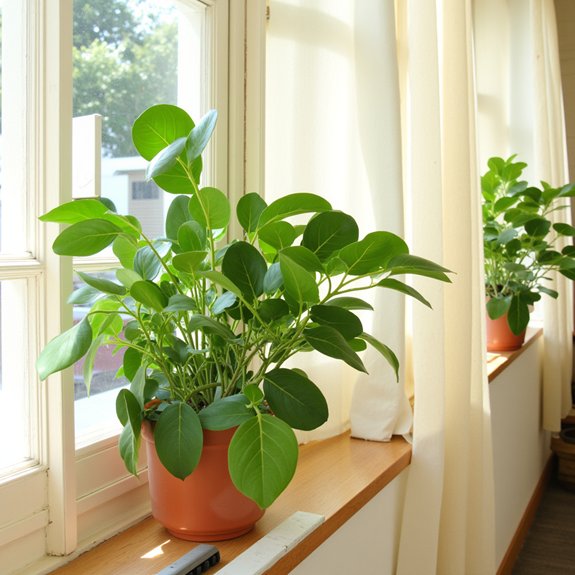Your Chinese money plant’s drooping leaves and yellowing stems aren’t just coincidence—they’re urgent signals demanding immediate attention. Whether you’re dealing with overwatering, root rot, or mysterious brown spots, identifying these symptoms quickly can mean the difference between saving your plant and watching it deteriorate. Most common issues stem from watering mistakes, poor lighting conditions, or environmental stress that you’ve probably overlooked. The real challenge lies in distinguishing between similar symptoms that require completely different solutions.
Contents
- 1 Watering Problems and Solutions
- 2 Common Leaf Issues and Their Causes
- 3 Root Health and Stem Problems
- 4 Growth Concerns and Stunted Development
- 5 Proper Lighting and Positioning
- 6 Pest Identification and Treatment
- 7 Environmental Conditions and Care Requirements
- 8 Soil, Fertilization, and Maintenance Practices
Watering Problems and Solutions

While Chinese money plants are relatively forgiving houseplants, watering issues cause 80% of their problems. Overwatering leads to root rot, yellowing leaves, and mushy stems. You’ll notice drooping, soft petioles when there’s too much moisture.
Underwatering creates equally troublesome symptoms. Your plant’s cells lack moisture, causing wilting and drooping leaves that feel dry to touch.
Check soil moisture levels before each watering session. Stick your finger one inch deep—if it’s still moist, wait. Establish a consistent watering frequency based on your home’s conditions, typically every 7-10 days. Proper drainage holes prevent waterlogging, while well-draining soil maintains healthy moisture levels.
Common Leaf Issues and Their Causes
Your Chinese money plant’s leaves tell a detailed story about its health, acting as visual indicators of underlying problems. Leaf curling happens when moisture levels drop too low or light becomes too intense, with inward curling signaling dehydration. Yellowing leaves typically indicate watering issues, especially overwatering that leads to root rot.
Brown patches appear when direct sunlight scorches delicate foliage. Watch for downward curling, which suggests waterlogged roots and poor drainage. Drooping occurs when cells lack moisture or petioles become soft from excess water. Leaf spots often signal fungal infections requiring better air circulation and pest monitoring.
Root Health and Stem Problems

Root rot represents the most serious threat to your Chinese money plant’s survival, often developing silently underground before visible symptoms appear above soil level. Poor drainage and overwatering create perfect conditions for fungal infections that destroy root health. You’ll notice yellowing leaves, mushy stems, and an overall decline before realizing the damage below.
Stem rot typically follows root problems, making the base soft and black. Once stem rot takes hold, saving your plant becomes nearly impossible. Check roots monthly by gently lifting the plant, looking for firm, white roots rather than brown, mushy ones.
Growth Concerns and Stunted Development
Unless you’re providing ideal growing conditions, your Chinese money plant will struggle to reach its full potential, often appearing smaller and weaker than expected. When growth expectations aren’t met, examine your light first—insufficient brightness halts photosynthesis completely.
Check if roots have filled the container, restricting development. You’ll need repotting into fresh, nutrient-rich soil immediately. Maintain proper nutrient balance with balanced fertilizer during growing season only.
Lack of new growth typically signals environmental stress. Monitor temperature, humidity, and watering consistency carefully. Missing offsets indicate plant distress, requiring adjusted care conditions for recovery.
Proper Lighting and Positioning

Where you position your Chinese money plant determines whether it thrives or merely survives in your home. Bright, indirect sunlight works best—think filtered morning sun through a sheer curtain. Direct afternoon rays will scorch those round leaves, creating unsightly brown patches you’ll regret.
Place your plant 3-6 feet from east or north-facing windows for ideal light exposure. South and west windows often provide too much intensity. Weekly plant rotation prevents lopsided growth, as your money plant naturally leans toward light sources.
Watch for leggy stems stretching toward windows—that’s your cue to move closer to better lighting.
Pest Identification and Treatment
Even with perfect lighting, your Chinese money plant can still fall victim to unwelcome guests that’ll quickly turn those pristine leaves into a pest playground. Spider mites create fine webbing, aphids cluster on new growth, and mealybugs look like white cotton balls. Check weekly for early detection, since understanding the pest lifecycle helps you target vulnerable stages effectively.
Treat infestations with insecticidal soap or neem oil, applying every 5-7 days until eliminated. Quarantine affected plants immediately. You can also introduce natural predators like ladybugs for aphid control, though this works better outdoors than indoors.
Environmental Conditions and Care Requirements
After you’ve conquered the pest battle, temperature becomes your plant’s next priority since Chinese money plants thrive in that sweet spot between 65-75°F. Cold drafts from windows or air vents stress your plant, causing leaf drop and stunted growth.
Temperature fluctuations wreak havoc on your plant’s stability, so keep it away from heating sources and doorways. Humidity levels matter just as much—aim for moderate to high humidity around 40-60%. Dry air browns leaf edges and slows growth.
Combat low humidity with a humidifier, pebble tray, or light misting. Your plant rewards consistent environmental conditions with healthy, vibrant foliage.
Soil, Fertilization, and Maintenance Practices
Beyond environmental factors, your Chinese money plant’s foundation literally starts with the soil beneath its roots. Well-draining potting mixes prevent waterlogging, while heavy soil types retain too much moisture, causing root rot. Choose a balanced, lightweight mix that allows excess water to escape quickly.
Your fertilization schedule should focus on the growing season only. Apply balanced, water-soluble fertilizer monthly from spring through summer, following package instructions carefully. Over-fertilization damages roots, so less is more.
Regular maintenance includes wiping dusty leaves with a damp cloth and pruning dead foliage. Repot every two years for soil refresh and healthier growth.
